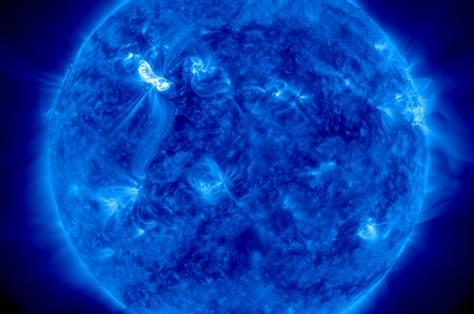March 8, 2012
Unusual combination of disturbances could affect air travel, power grids, and communications
The biggest solar storm in five years is battering our planet right now, and may cause disruptions to satellites, power grids and communications networks over the next 24 hours, space weather experts say.
March 8, 2012
Unusual combination of disturbances could affect air travel, power grids, and communications
The biggest solar storm in five years is battering our planet right now, and may cause disruptions to satellites, power grids and communications networks over the next 24 hours, space weather experts say.
Two strong solar flares erupted from the surface of the sun late Tuesday, blasting a wave of plasma and charged particles toward Earth. This eruption of material — called a coronal mass ejection or CME — sped through space at 4 million mph (6.4 million kilometers per hour).
The storm is expected to create strong disruptions due to an odd combination of intense magnetic, radio and radiation emissions, making it the strongest overall solar storm since December 2006, even though the flare that triggered it was not the largest, space weather officials said.
Early predictions estimated that the CME would likely Earth as early as 1:25 a.m. ET Thursday, with the brunt of it arriving at around 7 a.m. ET. The storm is not hitting Earth head-on but is instead delivering a glancing blow to the planet.
The CME will probably trigger geomagnetic and solar radiation storms, which could interfere with satellites in space and power grids on the ground, said Joseph Kunches, a space weather scientist at the National Oceanic and Atmospheric Administration's Space Weather Prediction Center. Aircraft that fly over the Earth's Polar Regions may experience communication issues as well, and some commercial airliners have already taken precautionary steps, Kunches said.
"There is the potential for induced currents in power grids," Kunches told reporters Wednesday. "Power grid operators have all been alerted. It could start to cause some unwanted induced currents."
The effects of this solar storm will likely last for 24 hours, and may possibly linger into Friday, Kunches said.
"Such a CME could result in a severe geomagnetic storm, causing aurora at low latitudes, with possible disruption to high frequency radio communication, global positioning systems (GPS) and power grids," NASA scientists said in a statement.
Experts also predict that the magnetic storm will likely enhance normal aurora displays (also known as the northern and southern lights). As the CME reaches Earth, these stunning light shows will be especially visible for people in northern latitudes, though the full moon of March, which also occurs Thursday, may interfere with the display.
"Skywatchers at all latitudes should be alert for auroras," astronomer Tony Phillips wrote on his website Spaceweather.com, which monitors space weather events.
Courtesy: space.com












































































































